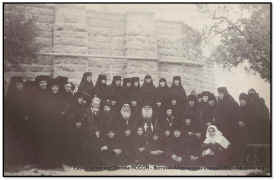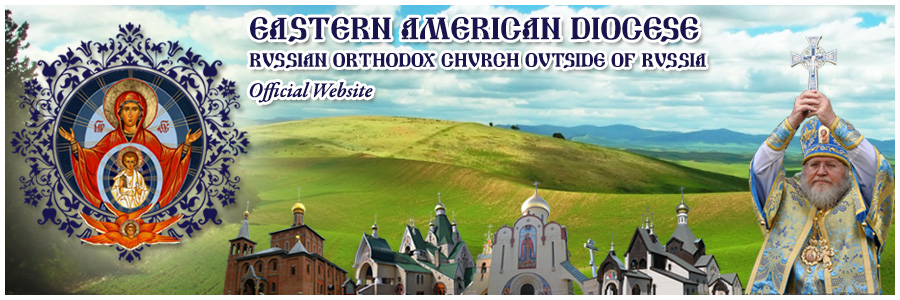The
Tomb of the Most Holy Virgin and Other Holy Sites and Historic Places
Archbishop Nikon (Rklitsky)
 After
the Church of the Holy Sepulcher and Resurrection, the principle place
of veneration in the Holy City is the Tomb of the Most Holy Virgin: a
cave in which the Mother of God was buried and where the immaculate body
of her who is "more honourable than the Cherubim and beyond compare
more glorious than the Seraphim" lay until her wondrous elevation
before the Throne of the Most Holy Trinity. The Tomb of the Most Holy
Virgin Mary lies adjacent to the Garden of Gethsemane. The cave-church
of the Dormition of the Mother of God also has several altars and
chapels belonging to various Christian denominations. About halfway down
the stairwell on the right-hand side is a Greek chapel with two altar
tables above the tombs of the holy ancestors of God Joachim and Anna,
while on the left-hand side is an Armenian chapel with an altar table
over the tomb of St. Joseph the Betrothed. The Tomb of the of the Mother
of God is a precious holy site, as well.
After
the Church of the Holy Sepulcher and Resurrection, the principle place
of veneration in the Holy City is the Tomb of the Most Holy Virgin: a
cave in which the Mother of God was buried and where the immaculate body
of her who is "more honourable than the Cherubim and beyond compare
more glorious than the Seraphim" lay until her wondrous elevation
before the Throne of the Most Holy Trinity. The Tomb of the Most Holy
Virgin Mary lies adjacent to the Garden of Gethsemane. The cave-church
of the Dormition of the Mother of God also has several altars and
chapels belonging to various Christian denominations. About halfway down
the stairwell on the right-hand side is a Greek chapel with two altar
tables above the tombs of the holy ancestors of God Joachim and Anna,
while on the left-hand side is an Armenian chapel with an altar table
over the tomb of St. Joseph the Betrothed. The Tomb of the of the Mother
of God is a precious holy site, as well.
In general, every piece of land and hill in Old Jerusalem – although
now covered by modern buildings – gives rise to precious, holy
memories, and bears witness to the mighty events of our Christian
antiquity.
Being unable even to properly describe these precious holy sites, we can
at least list them: the Via Dolorosa, the path the Savior walked on the
way to His Crucifixion; the Threshold of the Judgment Gate, through
which He stepped, being defended there by no man, although according to
the law of the day that ought to have happened, because an Innocent
Sufferer was being led to crucifixion; the grandiose Temple of Solomon,
where the Lord preached and exposed His enemies, and of which remains
only the place on which it stood; the Hill of Evil Counsel, where, in
the countryside palace of Caiaphas, it was decided to kill the Lord; the
city palace of Caiaphas, where the Lord was tried by an unjust trial and
subjected to spitting and beatings; Pilate’s palace and the Lithostrotos,
where the Lord was found innocent of all crimes and condemned to death;
the Pool of Bethesda at Solomon’s Temple; the Pool of Siloam; the
field of blood – the place bought for the thirty pieces of silver
thrown down by Judas in the Temple; the place where the first-martyr
Stephan was stoned, and many, many other places in Jerusalem, which are
so well known to Christians and which come alive in one’s mind when
one sees the places where they were and are, for buildings can be torn
down, but there is no changing what happened on a certain spot or on
some hill or mountain.
For us Russians, two holy places are especially precious, and we bear
especial responsibility for their preservation: the Mount of Olives and
Gethsemane.
The Mount of Olives is not only the location of the Lord’s Ascension
into Heaven, but it was also His favorite place, where the Lord would
rest and talk with His disciples after the deep grief and sorrows He
experienced during His preaching in the Temple, when he was greeted by
the fierce bitterness and animosity of His enemies, who resolved to kill
Him even long before His crucifixion. Now there are an hundred of our
nuns of the Mount of Olives, who ceaselessly pray there. There stands
the beautiful Church of the Ascension, the Chapel of St. John the
Forerunner, which stands on the place of the first and second findings
of St. John the Baptist’s head, taken there from Sebaste, the location
of Herod’s palace, where St. John was beheaded – his head was
preserved by Joanna, wife of Herod’s steward Chuza. Here there is a
large refectory-church. Above it was to be built the Church of the Last
Judgment, but its construction was halted due to the beginning of the
Second World War. Several feet from the Church of the Ascension is the
famous Mount of Olives Bell Tower, renowned for its marvelous peal. This
bell tower is visible from every point in Jerusalem and even its distant
environs.
Outside of Jerusalem, we can but list those holy places that the Lord
blessed us to visit. Above Jerusalem, in the mountains, is Bethlehem,
the Lord’s birthplace; Hebron, with the Oak of Mamre and the Tomb of
the Patriarchs; the Monastery of St. George the Chozebite, the Mount of
Temptation, where Christ fasted for forty days and was tempted by the
devil; Elisha’s Spring and Jericho; the Monastery of St. John the
Baptist and St. Gerasimos in the Jordan Desert, and the holy River
Jordan. In a slightly different direction from Jerusalem is Sebaste,
with the ruins of the palace and prison of Herod, where St. John the
Baptist was beheaded, and Jacob’s Well, where the Lord spoke with the
Samaritan woman.
Finally, on the Israeli side is Nazareth, where the Lord was raised and
educated, and where the Annunciation of the Most Holy Virgin Mary took
place. Even today, the city is cloaked in the mystery of the
Annunciation. There is an old Greek church over the well at which the
Immaculate Virgin sat and drew water, and a grand Catholic church is
being built nearby. Tiberias and the Sea of Galilee, surrounded by
mountains and having been preserved exactly as it was in the time of
Christ the Savior, and on its shores the remains of Capernaum, Cana, and
the majestic Mount Tabor of the Transfiguration, with the two churches
on its summit – one Greek and one Catholic.
Each of these holy names and holy places constitutes within itself both
the inspired preaching of the Gospel, which preserves those events that
transpired in these places, and the religio-historical narrative and
inexhaustible wellspring of inspiration, for this is the wellspring of
our resurrection not only in the life to come, but also of the
resurrection in a Christian life here on earth; it was for this that the
Lord walked this earth with His divine footsteps, suffered countless
sorrows and insults, embraced us all with His co-suffering love and,
finally, was mocked and crucified on the Cross, arose and ascended into
Heaven and lifted our souls up with Himself, uniting them unto Himself
by His labor of redemption of the human race.

